IMAT5209 - Human Interactions: Usability Evaluation Report
VerifiedAdded on 2022/10/04
|20
|5128
|12
Report
AI Summary
This report presents a usability evaluation of a food delivery application, focusing on human-computer interaction principles. It begins with an executive summary outlining the core concepts of usability, emphasizing the importance of user-friendly systems. The report then delves into the interactive system, its users, and relevant use cases, including actors like restaurants, customers, and delivery agents. It outlines key usability requirements such as effectiveness, efficiency, responsiveness, intuitiveness, accuracy, and customer satisfaction. The evaluation methodology employs heuristic methods, following guidelines for visibility, real-world matching, user control, consistency, error handling, and flexibility. The evaluation process involves analysis, modelling, and testing phases, using evaluators to assess the system's usability based on established criteria. The findings highlight areas for improvement and provide recommendations to enhance the overall user experience. The report concludes with a summary of the evaluation's outcomes and suggestions for future development, supported by references and an appendix.
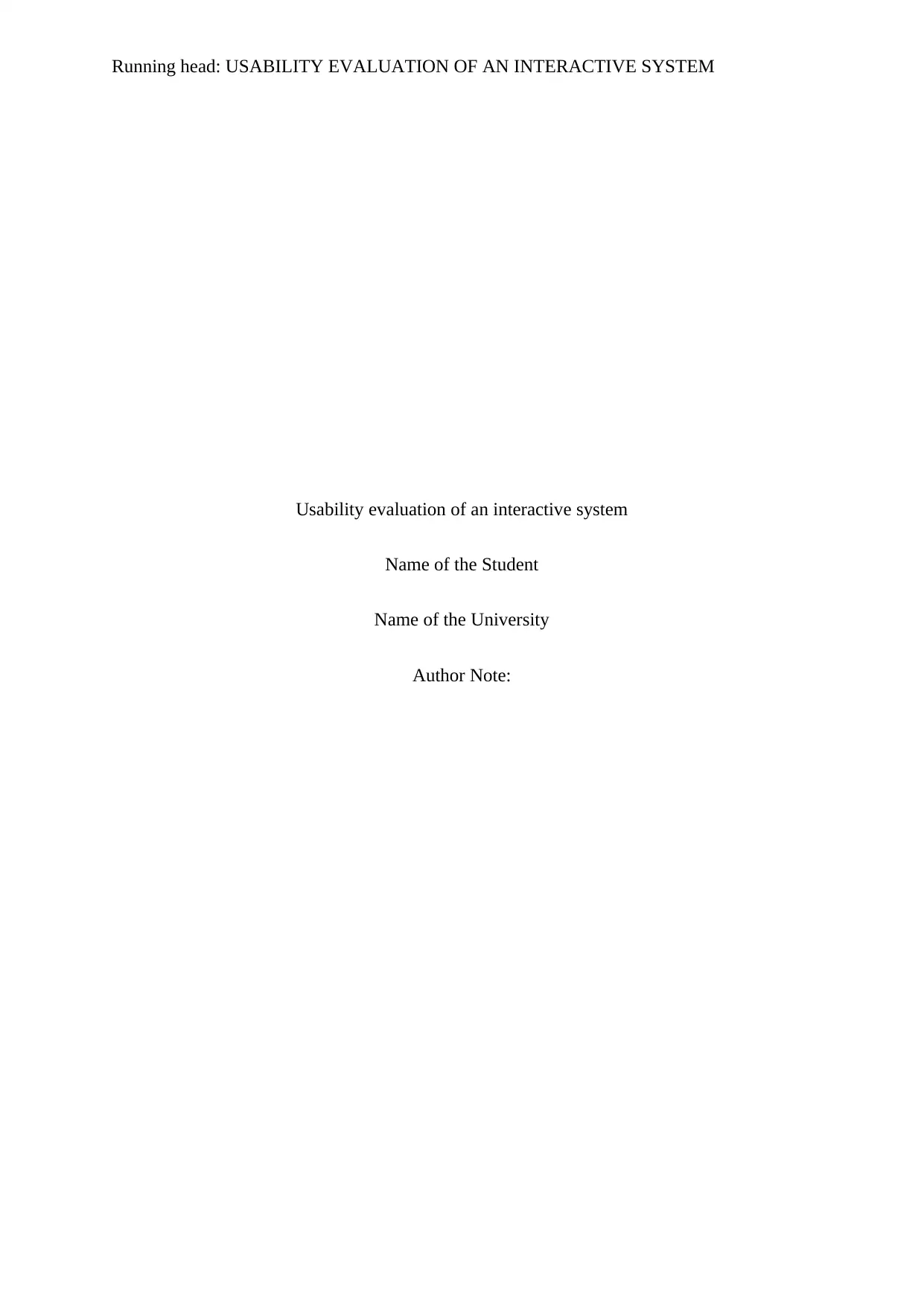
Running head: USABILITY EVALUATION OF AN INTERACTIVE SYSTEM
Usability evaluation of an interactive system
Name of the Student
Name of the University
Author Note:
Usability evaluation of an interactive system
Name of the Student
Name of the University
Author Note:
Paraphrase This Document
Need a fresh take? Get an instant paraphrase of this document with our AI Paraphraser
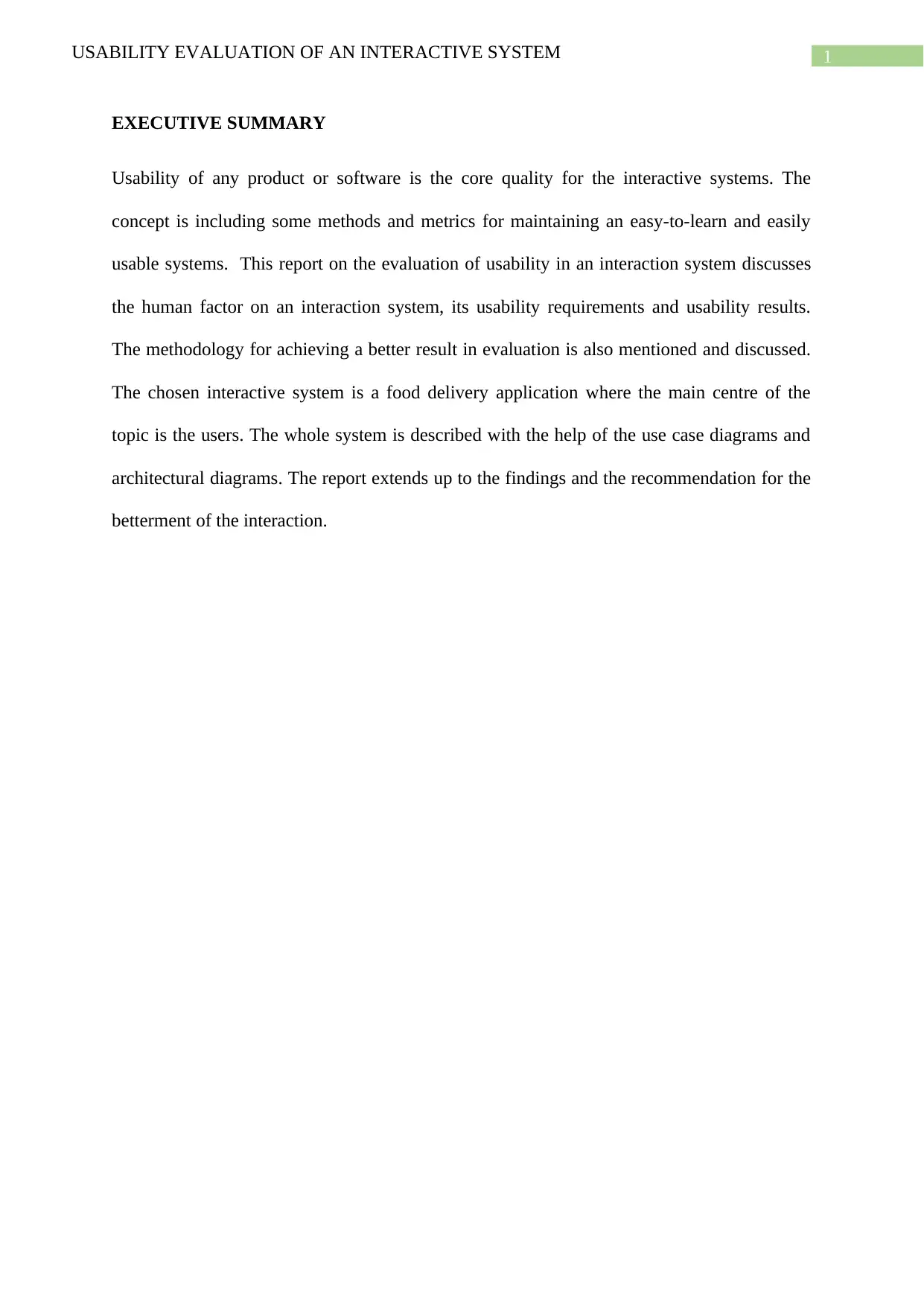
1USABILITY EVALUATION OF AN INTERACTIVE SYSTEM
EXECUTIVE SUMMARY
Usability of any product or software is the core quality for the interactive systems. The
concept is including some methods and metrics for maintaining an easy-to-learn and easily
usable systems. This report on the evaluation of usability in an interaction system discusses
the human factor on an interaction system, its usability requirements and usability results.
The methodology for achieving a better result in evaluation is also mentioned and discussed.
The chosen interactive system is a food delivery application where the main centre of the
topic is the users. The whole system is described with the help of the use case diagrams and
architectural diagrams. The report extends up to the findings and the recommendation for the
betterment of the interaction.
EXECUTIVE SUMMARY
Usability of any product or software is the core quality for the interactive systems. The
concept is including some methods and metrics for maintaining an easy-to-learn and easily
usable systems. This report on the evaluation of usability in an interaction system discusses
the human factor on an interaction system, its usability requirements and usability results.
The methodology for achieving a better result in evaluation is also mentioned and discussed.
The chosen interactive system is a food delivery application where the main centre of the
topic is the users. The whole system is described with the help of the use case diagrams and
architectural diagrams. The report extends up to the findings and the recommendation for the
betterment of the interaction.
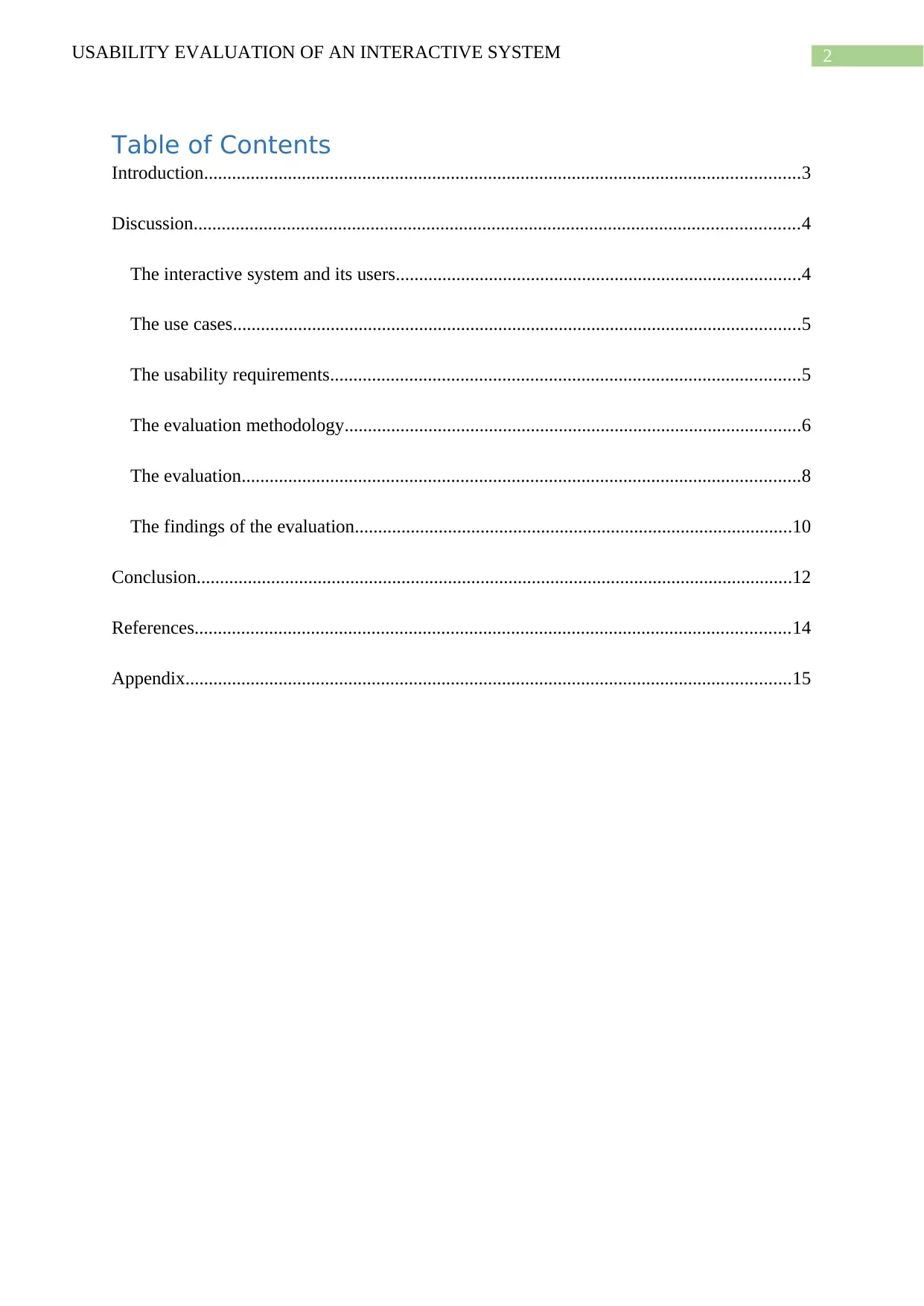
2USABILITY EVALUATION OF AN INTERACTIVE SYSTEM
Table of Contents
Introduction................................................................................................................................3
Discussion..................................................................................................................................4
The interactive system and its users.......................................................................................4
The use cases..........................................................................................................................5
The usability requirements.....................................................................................................5
The evaluation methodology..................................................................................................6
The evaluation........................................................................................................................8
The findings of the evaluation..............................................................................................10
Conclusion................................................................................................................................12
References................................................................................................................................14
Appendix..................................................................................................................................15
Table of Contents
Introduction................................................................................................................................3
Discussion..................................................................................................................................4
The interactive system and its users.......................................................................................4
The use cases..........................................................................................................................5
The usability requirements.....................................................................................................5
The evaluation methodology..................................................................................................6
The evaluation........................................................................................................................8
The findings of the evaluation..............................................................................................10
Conclusion................................................................................................................................12
References................................................................................................................................14
Appendix..................................................................................................................................15
⊘ This is a preview!⊘
Do you want full access?
Subscribe today to unlock all pages.

Trusted by 1+ million students worldwide
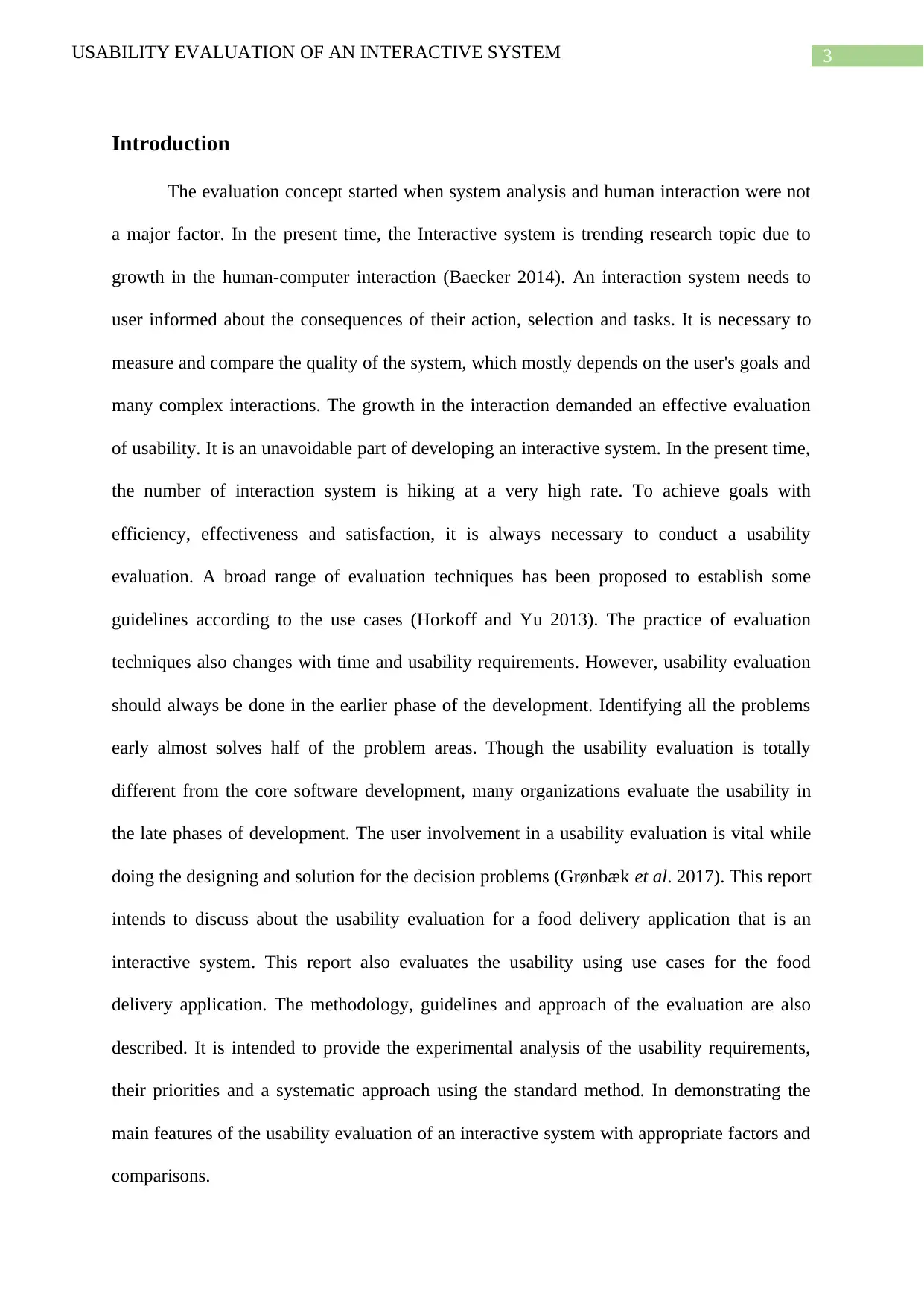
3USABILITY EVALUATION OF AN INTERACTIVE SYSTEM
Introduction
The evaluation concept started when system analysis and human interaction were not
a major factor. In the present time, the Interactive system is trending research topic due to
growth in the human-computer interaction (Baecker 2014). An interaction system needs to
user informed about the consequences of their action, selection and tasks. It is necessary to
measure and compare the quality of the system, which mostly depends on the user's goals and
many complex interactions. The growth in the interaction demanded an effective evaluation
of usability. It is an unavoidable part of developing an interactive system. In the present time,
the number of interaction system is hiking at a very high rate. To achieve goals with
efficiency, effectiveness and satisfaction, it is always necessary to conduct a usability
evaluation. A broad range of evaluation techniques has been proposed to establish some
guidelines according to the use cases (Horkoff and Yu 2013). The practice of evaluation
techniques also changes with time and usability requirements. However, usability evaluation
should always be done in the earlier phase of the development. Identifying all the problems
early almost solves half of the problem areas. Though the usability evaluation is totally
different from the core software development, many organizations evaluate the usability in
the late phases of development. The user involvement in a usability evaluation is vital while
doing the designing and solution for the decision problems (Grønbæk et al. 2017). This report
intends to discuss about the usability evaluation for a food delivery application that is an
interactive system. This report also evaluates the usability using use cases for the food
delivery application. The methodology, guidelines and approach of the evaluation are also
described. It is intended to provide the experimental analysis of the usability requirements,
their priorities and a systematic approach using the standard method. In demonstrating the
main features of the usability evaluation of an interactive system with appropriate factors and
comparisons.
Introduction
The evaluation concept started when system analysis and human interaction were not
a major factor. In the present time, the Interactive system is trending research topic due to
growth in the human-computer interaction (Baecker 2014). An interaction system needs to
user informed about the consequences of their action, selection and tasks. It is necessary to
measure and compare the quality of the system, which mostly depends on the user's goals and
many complex interactions. The growth in the interaction demanded an effective evaluation
of usability. It is an unavoidable part of developing an interactive system. In the present time,
the number of interaction system is hiking at a very high rate. To achieve goals with
efficiency, effectiveness and satisfaction, it is always necessary to conduct a usability
evaluation. A broad range of evaluation techniques has been proposed to establish some
guidelines according to the use cases (Horkoff and Yu 2013). The practice of evaluation
techniques also changes with time and usability requirements. However, usability evaluation
should always be done in the earlier phase of the development. Identifying all the problems
early almost solves half of the problem areas. Though the usability evaluation is totally
different from the core software development, many organizations evaluate the usability in
the late phases of development. The user involvement in a usability evaluation is vital while
doing the designing and solution for the decision problems (Grønbæk et al. 2017). This report
intends to discuss about the usability evaluation for a food delivery application that is an
interactive system. This report also evaluates the usability using use cases for the food
delivery application. The methodology, guidelines and approach of the evaluation are also
described. It is intended to provide the experimental analysis of the usability requirements,
their priorities and a systematic approach using the standard method. In demonstrating the
main features of the usability evaluation of an interactive system with appropriate factors and
comparisons.
Paraphrase This Document
Need a fresh take? Get an instant paraphrase of this document with our AI Paraphraser
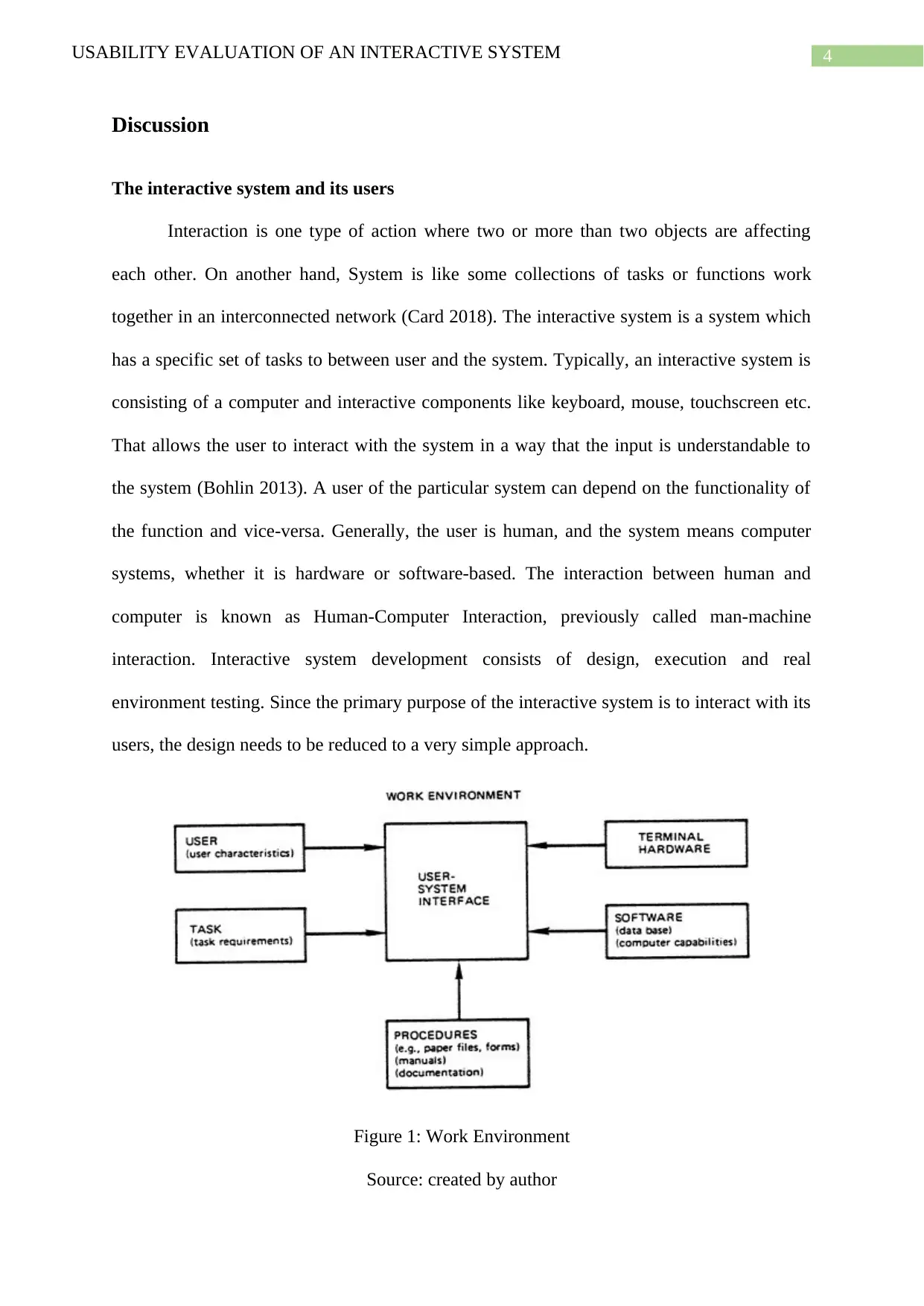
4USABILITY EVALUATION OF AN INTERACTIVE SYSTEM
Discussion
The interactive system and its users
Interaction is one type of action where two or more than two objects are affecting
each other. On another hand, System is like some collections of tasks or functions work
together in an interconnected network (Card 2018). The interactive system is a system which
has a specific set of tasks to between user and the system. Typically, an interactive system is
consisting of a computer and interactive components like keyboard, mouse, touchscreen etc.
That allows the user to interact with the system in a way that the input is understandable to
the system (Bohlin 2013). A user of the particular system can depend on the functionality of
the function and vice-versa. Generally, the user is human, and the system means computer
systems, whether it is hardware or software-based. The interaction between human and
computer is known as Human-Computer Interaction, previously called man-machine
interaction. Interactive system development consists of design, execution and real
environment testing. Since the primary purpose of the interactive system is to interact with its
users, the design needs to be reduced to a very simple approach.
Figure 1: Work Environment
Source: created by author
Discussion
The interactive system and its users
Interaction is one type of action where two or more than two objects are affecting
each other. On another hand, System is like some collections of tasks or functions work
together in an interconnected network (Card 2018). The interactive system is a system which
has a specific set of tasks to between user and the system. Typically, an interactive system is
consisting of a computer and interactive components like keyboard, mouse, touchscreen etc.
That allows the user to interact with the system in a way that the input is understandable to
the system (Bohlin 2013). A user of the particular system can depend on the functionality of
the function and vice-versa. Generally, the user is human, and the system means computer
systems, whether it is hardware or software-based. The interaction between human and
computer is known as Human-Computer Interaction, previously called man-machine
interaction. Interactive system development consists of design, execution and real
environment testing. Since the primary purpose of the interactive system is to interact with its
users, the design needs to be reduced to a very simple approach.
Figure 1: Work Environment
Source: created by author
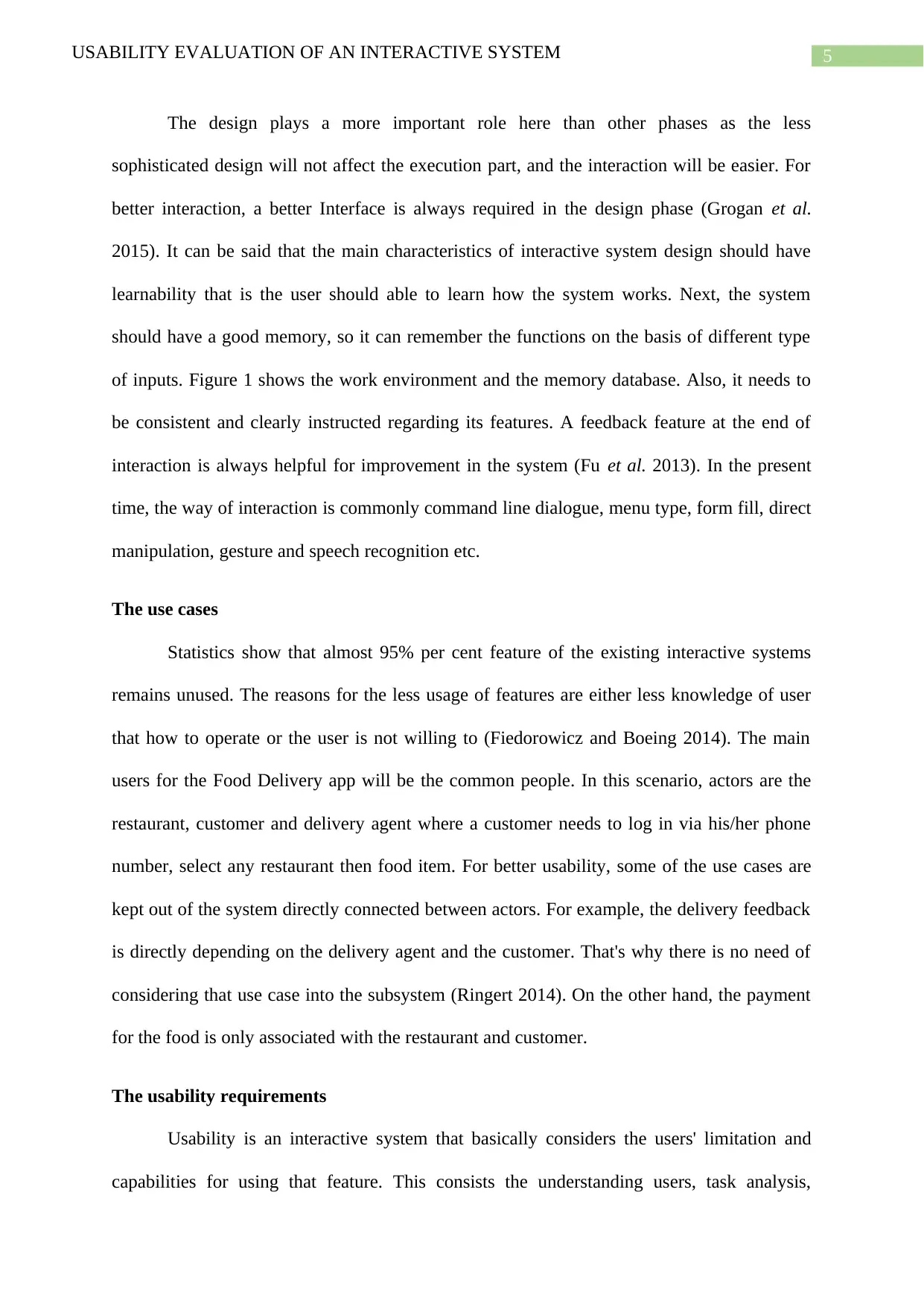
5USABILITY EVALUATION OF AN INTERACTIVE SYSTEM
The design plays a more important role here than other phases as the less
sophisticated design will not affect the execution part, and the interaction will be easier. For
better interaction, a better Interface is always required in the design phase (Grogan et al.
2015). It can be said that the main characteristics of interactive system design should have
learnability that is the user should able to learn how the system works. Next, the system
should have a good memory, so it can remember the functions on the basis of different type
of inputs. Figure 1 shows the work environment and the memory database. Also, it needs to
be consistent and clearly instructed regarding its features. A feedback feature at the end of
interaction is always helpful for improvement in the system (Fu et al. 2013). In the present
time, the way of interaction is commonly command line dialogue, menu type, form fill, direct
manipulation, gesture and speech recognition etc.
The use cases
Statistics show that almost 95% per cent feature of the existing interactive systems
remains unused. The reasons for the less usage of features are either less knowledge of user
that how to operate or the user is not willing to (Fiedorowicz and Boeing 2014). The main
users for the Food Delivery app will be the common people. In this scenario, actors are the
restaurant, customer and delivery agent where a customer needs to log in via his/her phone
number, select any restaurant then food item. For better usability, some of the use cases are
kept out of the system directly connected between actors. For example, the delivery feedback
is directly depending on the delivery agent and the customer. That's why there is no need of
considering that use case into the subsystem (Ringert 2014). On the other hand, the payment
for the food is only associated with the restaurant and customer.
The usability requirements
Usability is an interactive system that basically considers the users' limitation and
capabilities for using that feature. This consists the understanding users, task analysis,
The design plays a more important role here than other phases as the less
sophisticated design will not affect the execution part, and the interaction will be easier. For
better interaction, a better Interface is always required in the design phase (Grogan et al.
2015). It can be said that the main characteristics of interactive system design should have
learnability that is the user should able to learn how the system works. Next, the system
should have a good memory, so it can remember the functions on the basis of different type
of inputs. Figure 1 shows the work environment and the memory database. Also, it needs to
be consistent and clearly instructed regarding its features. A feedback feature at the end of
interaction is always helpful for improvement in the system (Fu et al. 2013). In the present
time, the way of interaction is commonly command line dialogue, menu type, form fill, direct
manipulation, gesture and speech recognition etc.
The use cases
Statistics show that almost 95% per cent feature of the existing interactive systems
remains unused. The reasons for the less usage of features are either less knowledge of user
that how to operate or the user is not willing to (Fiedorowicz and Boeing 2014). The main
users for the Food Delivery app will be the common people. In this scenario, actors are the
restaurant, customer and delivery agent where a customer needs to log in via his/her phone
number, select any restaurant then food item. For better usability, some of the use cases are
kept out of the system directly connected between actors. For example, the delivery feedback
is directly depending on the delivery agent and the customer. That's why there is no need of
considering that use case into the subsystem (Ringert 2014). On the other hand, the payment
for the food is only associated with the restaurant and customer.
The usability requirements
Usability is an interactive system that basically considers the users' limitation and
capabilities for using that feature. This consists the understanding users, task analysis,
⊘ This is a preview!⊘
Do you want full access?
Subscribe today to unlock all pages.

Trusted by 1+ million students worldwide
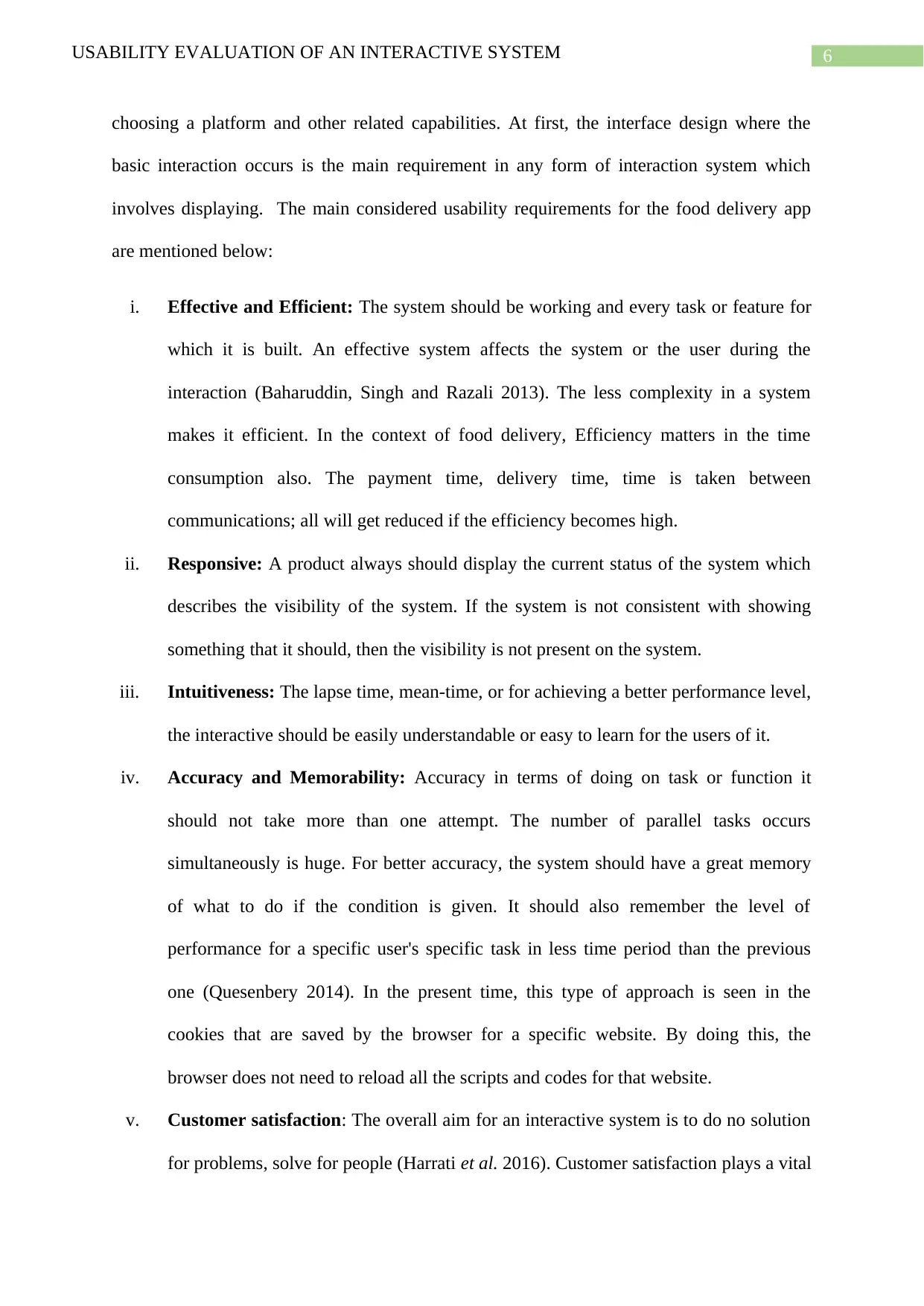
6USABILITY EVALUATION OF AN INTERACTIVE SYSTEM
choosing a platform and other related capabilities. At first, the interface design where the
basic interaction occurs is the main requirement in any form of interaction system which
involves displaying. The main considered usability requirements for the food delivery app
are mentioned below:
i. Effective and Efficient: The system should be working and every task or feature for
which it is built. An effective system affects the system or the user during the
interaction (Baharuddin, Singh and Razali 2013). The less complexity in a system
makes it efficient. In the context of food delivery, Efficiency matters in the time
consumption also. The payment time, delivery time, time is taken between
communications; all will get reduced if the efficiency becomes high.
ii. Responsive: A product always should display the current status of the system which
describes the visibility of the system. If the system is not consistent with showing
something that it should, then the visibility is not present on the system.
iii. Intuitiveness: The lapse time, mean-time, or for achieving a better performance level,
the interactive should be easily understandable or easy to learn for the users of it.
iv. Accuracy and Memorability: Accuracy in terms of doing on task or function it
should not take more than one attempt. The number of parallel tasks occurs
simultaneously is huge. For better accuracy, the system should have a great memory
of what to do if the condition is given. It should also remember the level of
performance for a specific user's specific task in less time period than the previous
one (Quesenbery 2014). In the present time, this type of approach is seen in the
cookies that are saved by the browser for a specific website. By doing this, the
browser does not need to reload all the scripts and codes for that website.
v. Customer satisfaction: The overall aim for an interactive system is to do no solution
for problems, solve for people (Harrati et al. 2016). Customer satisfaction plays a vital
choosing a platform and other related capabilities. At first, the interface design where the
basic interaction occurs is the main requirement in any form of interaction system which
involves displaying. The main considered usability requirements for the food delivery app
are mentioned below:
i. Effective and Efficient: The system should be working and every task or feature for
which it is built. An effective system affects the system or the user during the
interaction (Baharuddin, Singh and Razali 2013). The less complexity in a system
makes it efficient. In the context of food delivery, Efficiency matters in the time
consumption also. The payment time, delivery time, time is taken between
communications; all will get reduced if the efficiency becomes high.
ii. Responsive: A product always should display the current status of the system which
describes the visibility of the system. If the system is not consistent with showing
something that it should, then the visibility is not present on the system.
iii. Intuitiveness: The lapse time, mean-time, or for achieving a better performance level,
the interactive should be easily understandable or easy to learn for the users of it.
iv. Accuracy and Memorability: Accuracy in terms of doing on task or function it
should not take more than one attempt. The number of parallel tasks occurs
simultaneously is huge. For better accuracy, the system should have a great memory
of what to do if the condition is given. It should also remember the level of
performance for a specific user's specific task in less time period than the previous
one (Quesenbery 2014). In the present time, this type of approach is seen in the
cookies that are saved by the browser for a specific website. By doing this, the
browser does not need to reload all the scripts and codes for that website.
v. Customer satisfaction: The overall aim for an interactive system is to do no solution
for problems, solve for people (Harrati et al. 2016). Customer satisfaction plays a vital
Paraphrase This Document
Need a fresh take? Get an instant paraphrase of this document with our AI Paraphraser
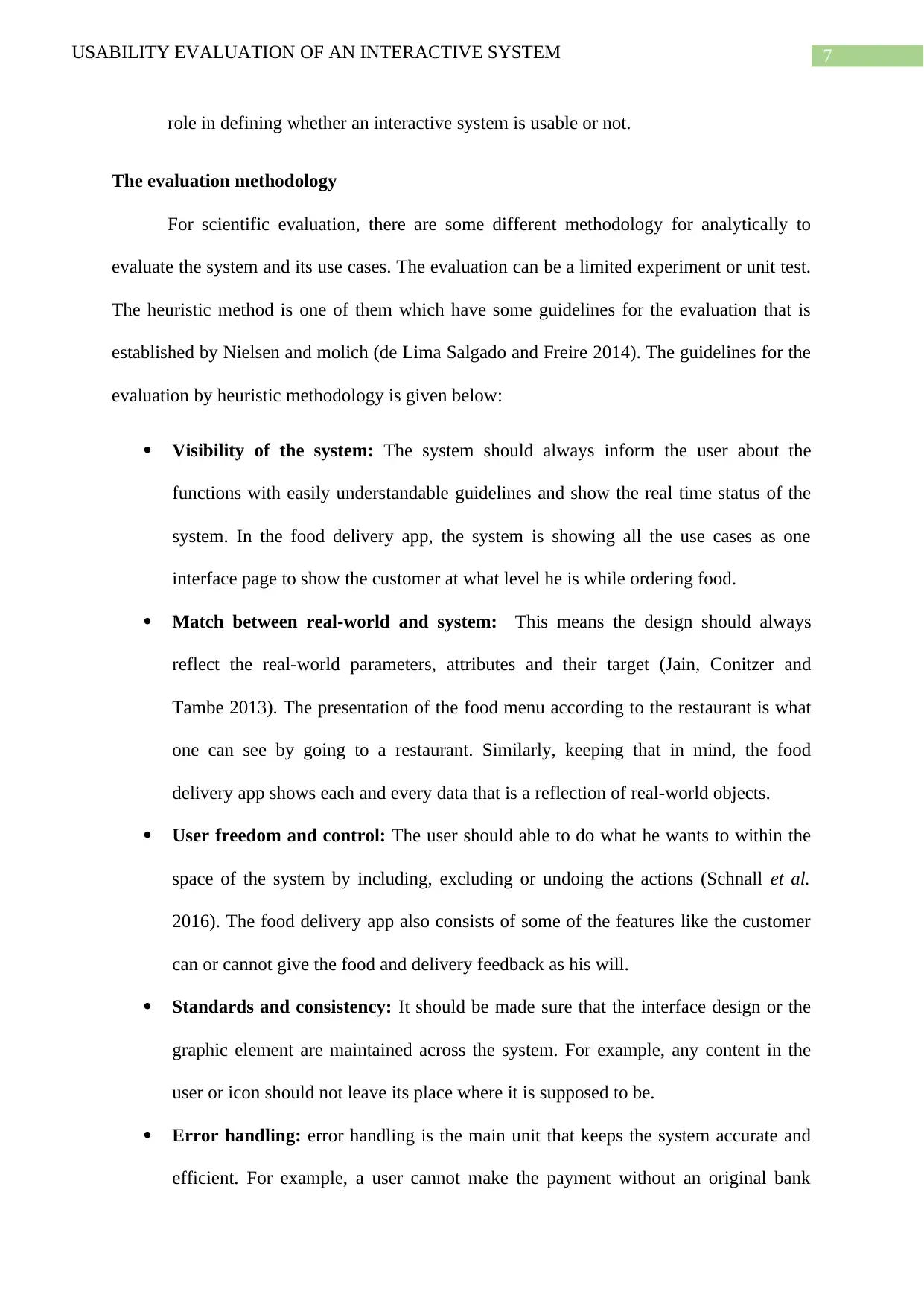
7USABILITY EVALUATION OF AN INTERACTIVE SYSTEM
role in defining whether an interactive system is usable or not.
The evaluation methodology
For scientific evaluation, there are some different methodology for analytically to
evaluate the system and its use cases. The evaluation can be a limited experiment or unit test.
The heuristic method is one of them which have some guidelines for the evaluation that is
established by Nielsen and molich (de Lima Salgado and Freire 2014). The guidelines for the
evaluation by heuristic methodology is given below:
Visibility of the system: The system should always inform the user about the
functions with easily understandable guidelines and show the real time status of the
system. In the food delivery app, the system is showing all the use cases as one
interface page to show the customer at what level he is while ordering food.
Match between real-world and system: This means the design should always
reflect the real-world parameters, attributes and their target (Jain, Conitzer and
Tambe 2013). The presentation of the food menu according to the restaurant is what
one can see by going to a restaurant. Similarly, keeping that in mind, the food
delivery app shows each and every data that is a reflection of real-world objects.
User freedom and control: The user should able to do what he wants to within the
space of the system by including, excluding or undoing the actions (Schnall et al.
2016). The food delivery app also consists of some of the features like the customer
can or cannot give the food and delivery feedback as his will.
Standards and consistency: It should be made sure that the interface design or the
graphic element are maintained across the system. For example, any content in the
user or icon should not leave its place where it is supposed to be.
Error handling: error handling is the main unit that keeps the system accurate and
efficient. For example, a user cannot make the payment without an original bank
role in defining whether an interactive system is usable or not.
The evaluation methodology
For scientific evaluation, there are some different methodology for analytically to
evaluate the system and its use cases. The evaluation can be a limited experiment or unit test.
The heuristic method is one of them which have some guidelines for the evaluation that is
established by Nielsen and molich (de Lima Salgado and Freire 2014). The guidelines for the
evaluation by heuristic methodology is given below:
Visibility of the system: The system should always inform the user about the
functions with easily understandable guidelines and show the real time status of the
system. In the food delivery app, the system is showing all the use cases as one
interface page to show the customer at what level he is while ordering food.
Match between real-world and system: This means the design should always
reflect the real-world parameters, attributes and their target (Jain, Conitzer and
Tambe 2013). The presentation of the food menu according to the restaurant is what
one can see by going to a restaurant. Similarly, keeping that in mind, the food
delivery app shows each and every data that is a reflection of real-world objects.
User freedom and control: The user should able to do what he wants to within the
space of the system by including, excluding or undoing the actions (Schnall et al.
2016). The food delivery app also consists of some of the features like the customer
can or cannot give the food and delivery feedback as his will.
Standards and consistency: It should be made sure that the interface design or the
graphic element are maintained across the system. For example, any content in the
user or icon should not leave its place where it is supposed to be.
Error handling: error handling is the main unit that keeps the system accurate and
efficient. For example, a user cannot make the payment without an original bank
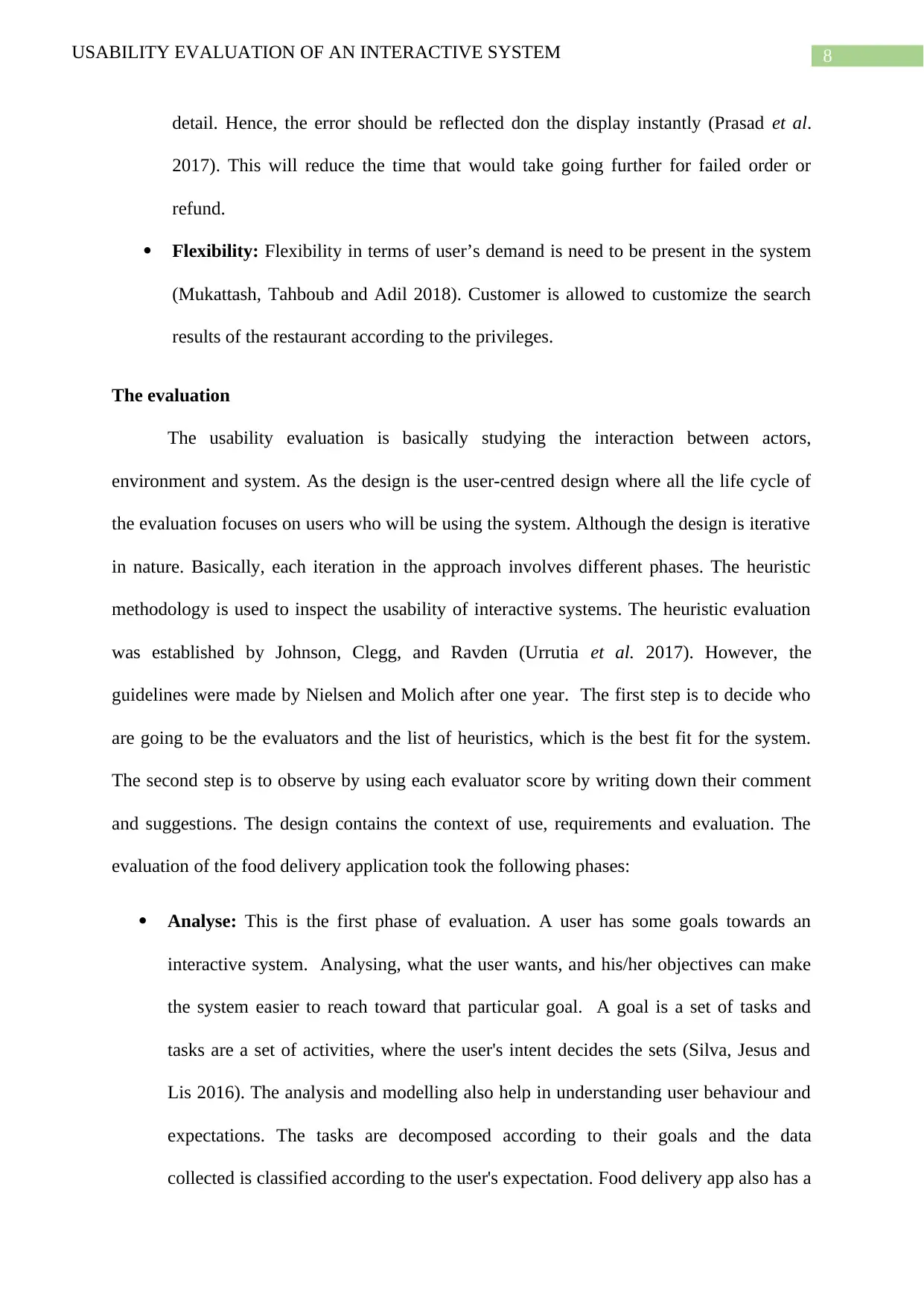
8USABILITY EVALUATION OF AN INTERACTIVE SYSTEM
detail. Hence, the error should be reflected don the display instantly (Prasad et al.
2017). This will reduce the time that would take going further for failed order or
refund.
Flexibility: Flexibility in terms of user’s demand is need to be present in the system
(Mukattash, Tahboub and Adil 2018). Customer is allowed to customize the search
results of the restaurant according to the privileges.
The evaluation
The usability evaluation is basically studying the interaction between actors,
environment and system. As the design is the user-centred design where all the life cycle of
the evaluation focuses on users who will be using the system. Although the design is iterative
in nature. Basically, each iteration in the approach involves different phases. The heuristic
methodology is used to inspect the usability of interactive systems. The heuristic evaluation
was established by Johnson, Clegg, and Ravden (Urrutia et al. 2017). However, the
guidelines were made by Nielsen and Molich after one year. The first step is to decide who
are going to be the evaluators and the list of heuristics, which is the best fit for the system.
The second step is to observe by using each evaluator score by writing down their comment
and suggestions. The design contains the context of use, requirements and evaluation. The
evaluation of the food delivery application took the following phases:
Analyse: This is the first phase of evaluation. A user has some goals towards an
interactive system. Analysing, what the user wants, and his/her objectives can make
the system easier to reach toward that particular goal. A goal is a set of tasks and
tasks are a set of activities, where the user's intent decides the sets (Silva, Jesus and
Lis 2016). The analysis and modelling also help in understanding user behaviour and
expectations. The tasks are decomposed according to their goals and the data
collected is classified according to the user's expectation. Food delivery app also has a
detail. Hence, the error should be reflected don the display instantly (Prasad et al.
2017). This will reduce the time that would take going further for failed order or
refund.
Flexibility: Flexibility in terms of user’s demand is need to be present in the system
(Mukattash, Tahboub and Adil 2018). Customer is allowed to customize the search
results of the restaurant according to the privileges.
The evaluation
The usability evaluation is basically studying the interaction between actors,
environment and system. As the design is the user-centred design where all the life cycle of
the evaluation focuses on users who will be using the system. Although the design is iterative
in nature. Basically, each iteration in the approach involves different phases. The heuristic
methodology is used to inspect the usability of interactive systems. The heuristic evaluation
was established by Johnson, Clegg, and Ravden (Urrutia et al. 2017). However, the
guidelines were made by Nielsen and Molich after one year. The first step is to decide who
are going to be the evaluators and the list of heuristics, which is the best fit for the system.
The second step is to observe by using each evaluator score by writing down their comment
and suggestions. The design contains the context of use, requirements and evaluation. The
evaluation of the food delivery application took the following phases:
Analyse: This is the first phase of evaluation. A user has some goals towards an
interactive system. Analysing, what the user wants, and his/her objectives can make
the system easier to reach toward that particular goal. A goal is a set of tasks and
tasks are a set of activities, where the user's intent decides the sets (Silva, Jesus and
Lis 2016). The analysis and modelling also help in understanding user behaviour and
expectations. The tasks are decomposed according to their goals and the data
collected is classified according to the user's expectation. Food delivery app also has a
⊘ This is a preview!⊘
Do you want full access?
Subscribe today to unlock all pages.

Trusted by 1+ million students worldwide
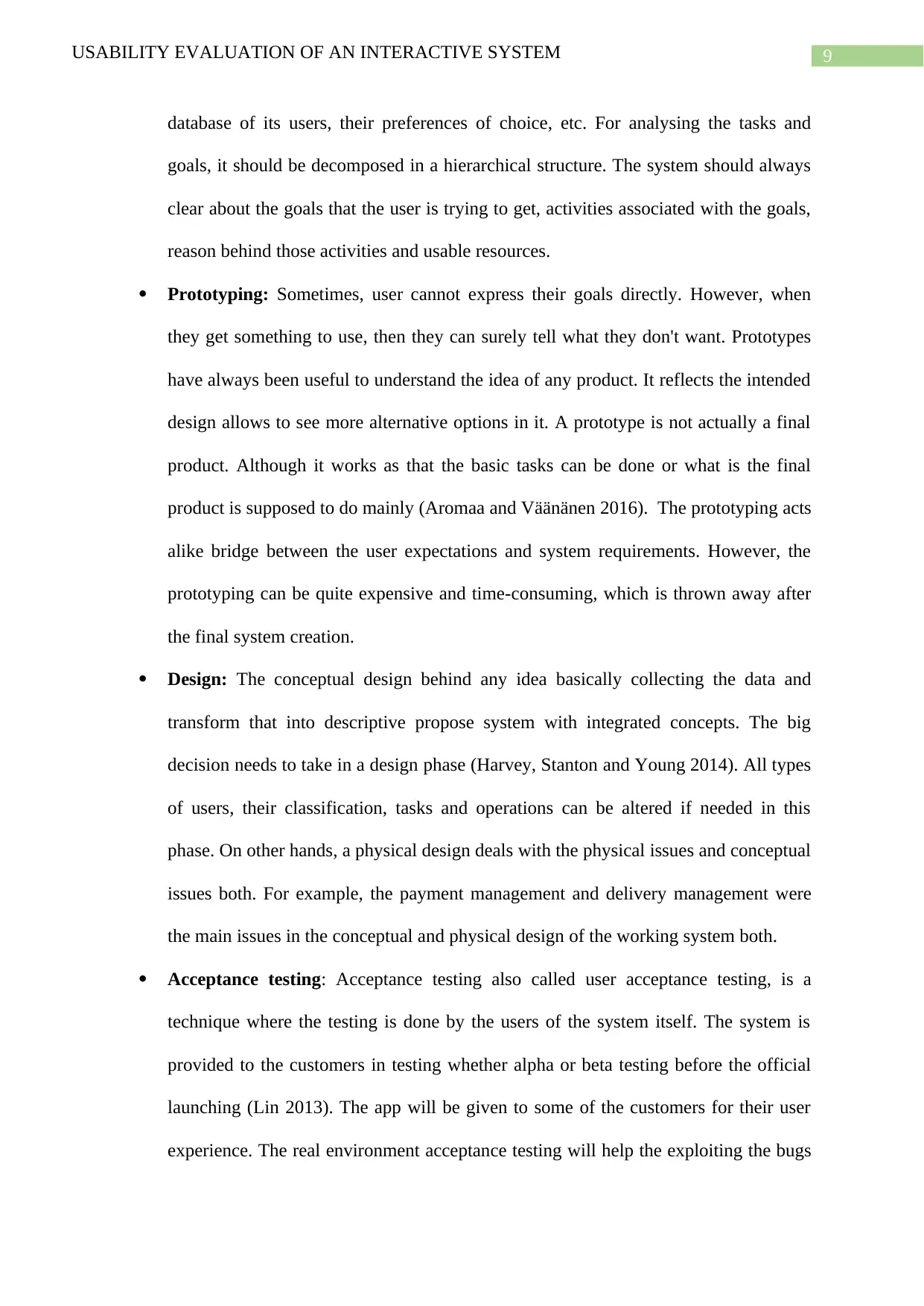
9USABILITY EVALUATION OF AN INTERACTIVE SYSTEM
database of its users, their preferences of choice, etc. For analysing the tasks and
goals, it should be decomposed in a hierarchical structure. The system should always
clear about the goals that the user is trying to get, activities associated with the goals,
reason behind those activities and usable resources.
Prototyping: Sometimes, user cannot express their goals directly. However, when
they get something to use, then they can surely tell what they don't want. Prototypes
have always been useful to understand the idea of any product. It reflects the intended
design allows to see more alternative options in it. A prototype is not actually a final
product. Although it works as that the basic tasks can be done or what is the final
product is supposed to do mainly (Aromaa and Väänänen 2016). The prototyping acts
alike bridge between the user expectations and system requirements. However, the
prototyping can be quite expensive and time-consuming, which is thrown away after
the final system creation.
Design: The conceptual design behind any idea basically collecting the data and
transform that into descriptive propose system with integrated concepts. The big
decision needs to take in a design phase (Harvey, Stanton and Young 2014). All types
of users, their classification, tasks and operations can be altered if needed in this
phase. On other hands, a physical design deals with the physical issues and conceptual
issues both. For example, the payment management and delivery management were
the main issues in the conceptual and physical design of the working system both.
Acceptance testing: Acceptance testing also called user acceptance testing, is a
technique where the testing is done by the users of the system itself. The system is
provided to the customers in testing whether alpha or beta testing before the official
launching (Lin 2013). The app will be given to some of the customers for their user
experience. The real environment acceptance testing will help the exploiting the bugs
database of its users, their preferences of choice, etc. For analysing the tasks and
goals, it should be decomposed in a hierarchical structure. The system should always
clear about the goals that the user is trying to get, activities associated with the goals,
reason behind those activities and usable resources.
Prototyping: Sometimes, user cannot express their goals directly. However, when
they get something to use, then they can surely tell what they don't want. Prototypes
have always been useful to understand the idea of any product. It reflects the intended
design allows to see more alternative options in it. A prototype is not actually a final
product. Although it works as that the basic tasks can be done or what is the final
product is supposed to do mainly (Aromaa and Väänänen 2016). The prototyping acts
alike bridge between the user expectations and system requirements. However, the
prototyping can be quite expensive and time-consuming, which is thrown away after
the final system creation.
Design: The conceptual design behind any idea basically collecting the data and
transform that into descriptive propose system with integrated concepts. The big
decision needs to take in a design phase (Harvey, Stanton and Young 2014). All types
of users, their classification, tasks and operations can be altered if needed in this
phase. On other hands, a physical design deals with the physical issues and conceptual
issues both. For example, the payment management and delivery management were
the main issues in the conceptual and physical design of the working system both.
Acceptance testing: Acceptance testing also called user acceptance testing, is a
technique where the testing is done by the users of the system itself. The system is
provided to the customers in testing whether alpha or beta testing before the official
launching (Lin 2013). The app will be given to some of the customers for their user
experience. The real environment acceptance testing will help the exploiting the bugs
Paraphrase This Document
Need a fresh take? Get an instant paraphrase of this document with our AI Paraphraser
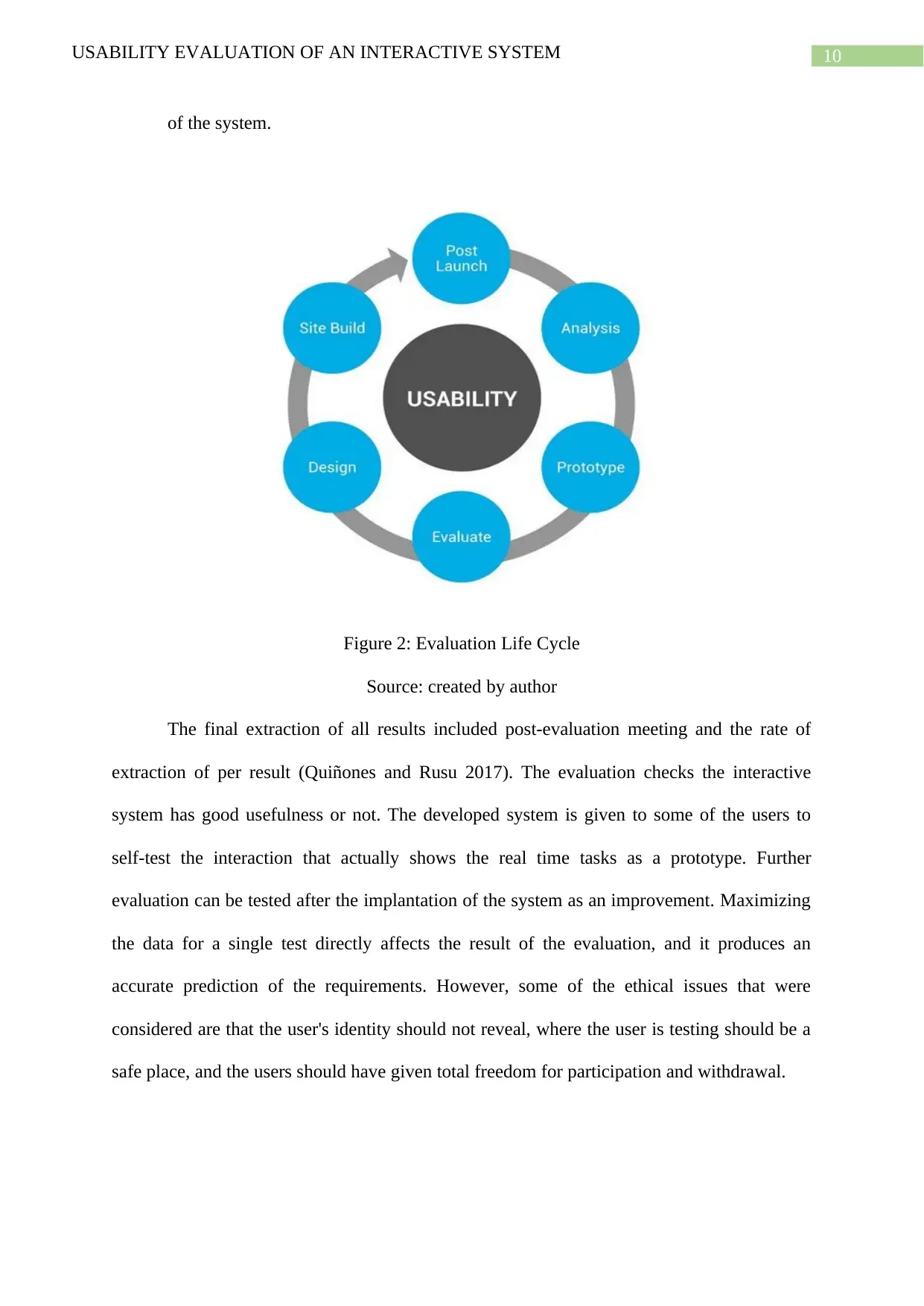
10USABILITY EVALUATION OF AN INTERACTIVE SYSTEM
of the system.
Figure 2: Evaluation Life Cycle
Source: created by author
The final extraction of all results included post-evaluation meeting and the rate of
extraction of per result (Quiñones and Rusu 2017). The evaluation checks the interactive
system has good usefulness or not. The developed system is given to some of the users to
self-test the interaction that actually shows the real time tasks as a prototype. Further
evaluation can be tested after the implantation of the system as an improvement. Maximizing
the data for a single test directly affects the result of the evaluation, and it produces an
accurate prediction of the requirements. However, some of the ethical issues that were
considered are that the user's identity should not reveal, where the user is testing should be a
safe place, and the users should have given total freedom for participation and withdrawal.
of the system.
Figure 2: Evaluation Life Cycle
Source: created by author
The final extraction of all results included post-evaluation meeting and the rate of
extraction of per result (Quiñones and Rusu 2017). The evaluation checks the interactive
system has good usefulness or not. The developed system is given to some of the users to
self-test the interaction that actually shows the real time tasks as a prototype. Further
evaluation can be tested after the implantation of the system as an improvement. Maximizing
the data for a single test directly affects the result of the evaluation, and it produces an
accurate prediction of the requirements. However, some of the ethical issues that were
considered are that the user's identity should not reveal, where the user is testing should be a
safe place, and the users should have given total freedom for participation and withdrawal.
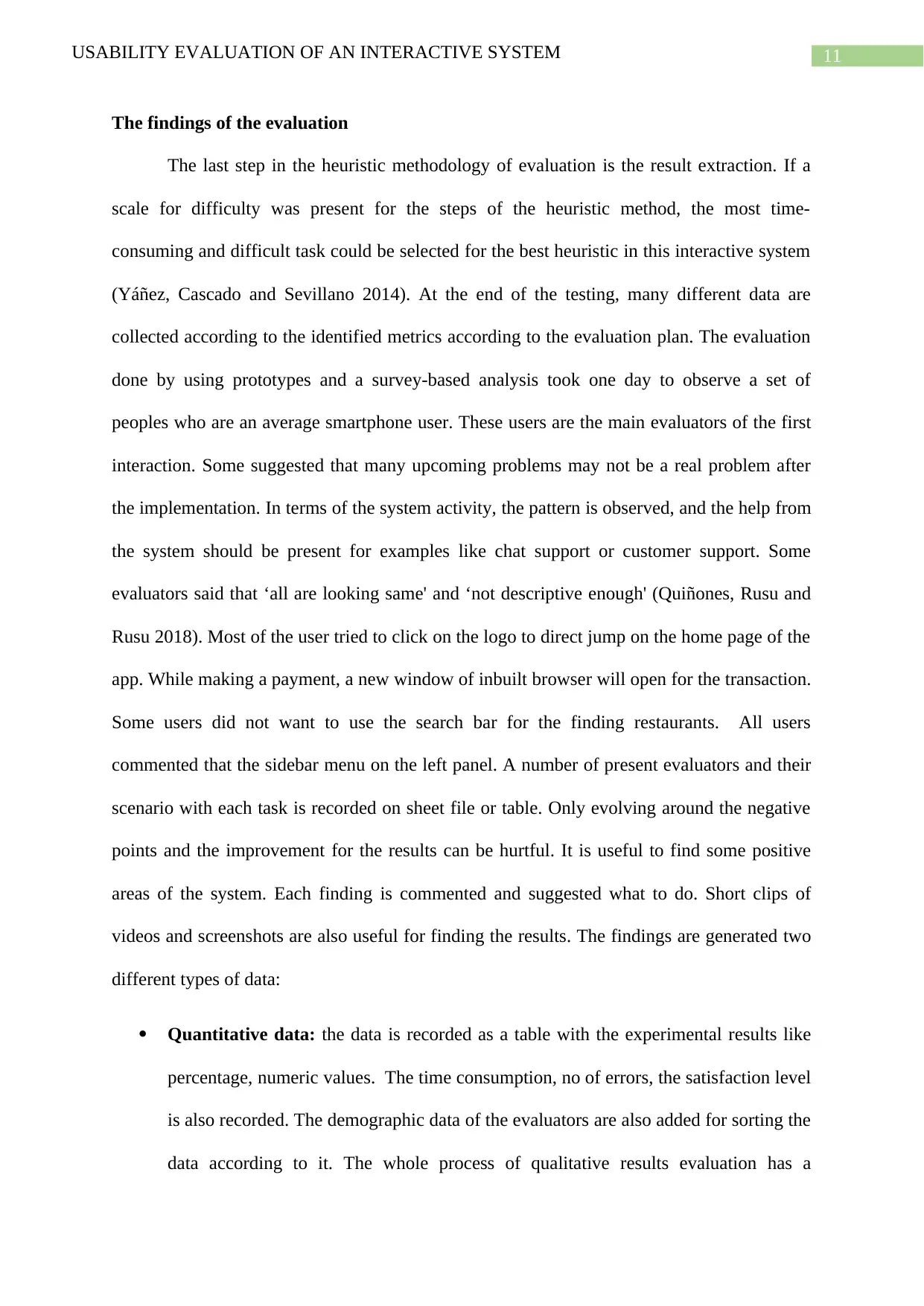
11USABILITY EVALUATION OF AN INTERACTIVE SYSTEM
The findings of the evaluation
The last step in the heuristic methodology of evaluation is the result extraction. If a
scale for difficulty was present for the steps of the heuristic method, the most time-
consuming and difficult task could be selected for the best heuristic in this interactive system
(Yáñez, Cascado and Sevillano 2014). At the end of the testing, many different data are
collected according to the identified metrics according to the evaluation plan. The evaluation
done by using prototypes and a survey-based analysis took one day to observe a set of
peoples who are an average smartphone user. These users are the main evaluators of the first
interaction. Some suggested that many upcoming problems may not be a real problem after
the implementation. In terms of the system activity, the pattern is observed, and the help from
the system should be present for examples like chat support or customer support. Some
evaluators said that ‘all are looking same' and ‘not descriptive enough' (Quiñones, Rusu and
Rusu 2018). Most of the user tried to click on the logo to direct jump on the home page of the
app. While making a payment, a new window of inbuilt browser will open for the transaction.
Some users did not want to use the search bar for the finding restaurants. All users
commented that the sidebar menu on the left panel. A number of present evaluators and their
scenario with each task is recorded on sheet file or table. Only evolving around the negative
points and the improvement for the results can be hurtful. It is useful to find some positive
areas of the system. Each finding is commented and suggested what to do. Short clips of
videos and screenshots are also useful for finding the results. The findings are generated two
different types of data:
Quantitative data: the data is recorded as a table with the experimental results like
percentage, numeric values. The time consumption, no of errors, the satisfaction level
is also recorded. The demographic data of the evaluators are also added for sorting the
data according to it. The whole process of qualitative results evaluation has a
The findings of the evaluation
The last step in the heuristic methodology of evaluation is the result extraction. If a
scale for difficulty was present for the steps of the heuristic method, the most time-
consuming and difficult task could be selected for the best heuristic in this interactive system
(Yáñez, Cascado and Sevillano 2014). At the end of the testing, many different data are
collected according to the identified metrics according to the evaluation plan. The evaluation
done by using prototypes and a survey-based analysis took one day to observe a set of
peoples who are an average smartphone user. These users are the main evaluators of the first
interaction. Some suggested that many upcoming problems may not be a real problem after
the implementation. In terms of the system activity, the pattern is observed, and the help from
the system should be present for examples like chat support or customer support. Some
evaluators said that ‘all are looking same' and ‘not descriptive enough' (Quiñones, Rusu and
Rusu 2018). Most of the user tried to click on the logo to direct jump on the home page of the
app. While making a payment, a new window of inbuilt browser will open for the transaction.
Some users did not want to use the search bar for the finding restaurants. All users
commented that the sidebar menu on the left panel. A number of present evaluators and their
scenario with each task is recorded on sheet file or table. Only evolving around the negative
points and the improvement for the results can be hurtful. It is useful to find some positive
areas of the system. Each finding is commented and suggested what to do. Short clips of
videos and screenshots are also useful for finding the results. The findings are generated two
different types of data:
Quantitative data: the data is recorded as a table with the experimental results like
percentage, numeric values. The time consumption, no of errors, the satisfaction level
is also recorded. The demographic data of the evaluators are also added for sorting the
data according to it. The whole process of qualitative results evaluation has a
⊘ This is a preview!⊘
Do you want full access?
Subscribe today to unlock all pages.

Trusted by 1+ million students worldwide
1 out of 20
Related Documents
Your All-in-One AI-Powered Toolkit for Academic Success.
+13062052269
info@desklib.com
Available 24*7 on WhatsApp / Email
![[object Object]](/_next/static/media/star-bottom.7253800d.svg)
Unlock your academic potential
Copyright © 2020–2025 A2Z Services. All Rights Reserved. Developed and managed by ZUCOL.



